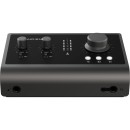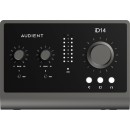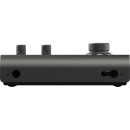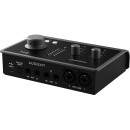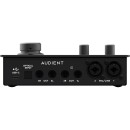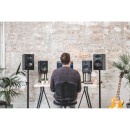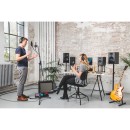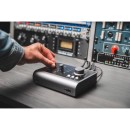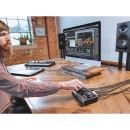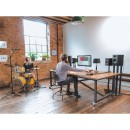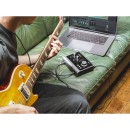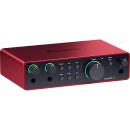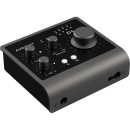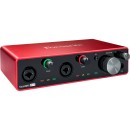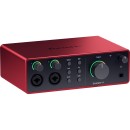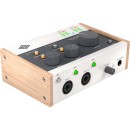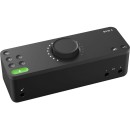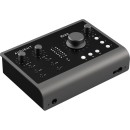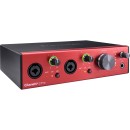Audient iD14 MKII Desktop 10x6 USB Type-C Audio Interface Review
- 10-in/6-out USB Type-C audio interface
- 2 Audient Console Mic Preamps
- Class-leading converters
- 1 JFET DI instrument input
- 1 dual headphone output
- ADAT input for expandability
- 3 user-defined function buttons
- ScrollControl feature
- Bus-powered via USB-C
- Bundled with comprehensive software and plug-ins
Specifications, Advantages, and Disadvantages of the Audient iD14 MKII
The Audient iD14 MKII Desktop 10x6 USB Type-C Audio Interface is a high-performance audio interface designed for musicians, producers, and audio engineers. It features two Audient Console mic preamps, renowned for their quality and clarity, ensuring pristine audio capture. The unit also includes a JFET instrument input that emulates the input stage of a classic valve amplifier, providing rich harmonics and a natural tone for direct recordings.
This interface offers a comprehensive set of I/O options with its 10 inputs and 6 outputs, including an optical input for ADAT or S/PDIF expansion, making it versatile enough to handle various recording setups. The USB Type-C connectivity ensures fast and reliable data transfer, along with low latency performance. Additionally, the iD14 MKII boasts high-grade converters with a 120dB dynamic range, delivering professional-grade sound quality.
The iD14 MKII also features Audient's intuitive ScrollControl, which allows the volume encoder to be used as a virtual scroll wheel, enhancing workflow efficiency. The interface is bus-powered, eliminating the need for an external power supply, and its solid build ensures durability. With its blend of high-quality components, versatile features, and user-friendly design, the Audient iD14 MKII is a top choice for anyone seeking a reliable and high-fidelity audio interface.
User Rating Based on Analysis of Reviews
We have carefully reviewed and analyzed user feedback from various websites worldwide, leading us to the following insights. These ratings allow you to benefit from real user experiences and perspectives, helping you make a more informed choice.
Sound Quality
92% of users praised the Audient iD14 MKII for its exceptional sound quality, highlighting the clarity and precision it brings to recordings. Many users noted that the preamps offer a professional-grade audio experience, making it an ideal choice for studio settings. The high-resolution converters were appreciated for maintaining audio fidelity, even at higher volumes, providing a clear and natural sound.
8% of users expressed dissatisfaction with the sound quality, pointing out occasional noise issues or interference during recordings. Some users felt that the interface did not significantly improve audio quality compared to other similar products they had used, feeling that the sound enhancement was not as pronounced as expected.
Build Quality
89% of users were impressed with the robust build quality of the Audient iD14 MKII. They appreciated the solid metal construction, which not only provides durability but also a premium feel. The sturdy design reassured users of the product's longevity, especially for those frequently transporting the device between different locations for recording sessions.
11% of users were not satisfied with the build quality, citing issues such as loose knobs or buttons that did not feel as secure as expected. A few users reported that the device seemed prone to scratches or cosmetic wear, which diminished the overall premium feel they anticipated at the price point.
Ease of Use
85% of users found the Audient iD14 MKII to be user-friendly, with an intuitive interface that makes setup and operation straightforward. The simple yet effective control layout was appreciated, allowing even beginners to navigate the device without extensive technical knowledge. Users also valued the helpful indicators and clear labeling, which reduced setup time and troubleshooting.
15% of users found the device somewhat challenging to use, especially those new to audio interfaces. They mentioned that the lack of a comprehensive manual made it difficult to understand some of the more advanced features, and the software integration could be more seamless. Some also felt that the initial setup required more time than they expected.
Connectivity Options
88% of users were satisfied with the connectivity options offered by the Audient iD14 MKII, appreciating the USB Type-C interface for its speed and compatibility with modern devices. The inclusion of both XLR and instrument inputs was seen as versatile, catering to a wide range of recording needs. Users also liked the additional optical input for expanding channel capacity.
12% of users were dissatisfied with the connectivity options, primarily due to the lack of MIDI input/output, which they felt limited its functionality for certain setups. Some users also experienced difficulties with the USB connection, reporting that it occasionally disconnected or required reconnection to maintain a stable link.
Software Integration
82% of users appreciated the software integration with the Audient iD14 MKII, noting that it worked well with major digital audio workstations (DAWs) and provided useful features for detailed audio editing. Users found the accompanying software intuitive and largely bug-free, enhancing their overall recording experience.
18% of users expressed dissatisfaction with the software integration, mentioning issues like compatibility problems with certain DAWs and occasional glitches. Some users found the software interface outdated or not as intuitive as they hoped, leading to a steeper learning curve and frustration during use.
Portability
87% of users appreciated the portability of the Audient iD14 MKII, highlighting its compact size and light weight, which make it easy to transport for mobile recording sessions. The sturdy build also contributed to confidence in its ability to withstand travel without damage.
13% of users were not fully satisfied with the portability, citing the need for additional cables and power adapters as a hindrance. Some also felt that the device was slightly bulkier than they preferred for a truly portable setup, limiting its convenience for frequent travel.
Latency Performance
90% of users praised the low latency performance of the Audient iD14 MKII, appreciating how it allows real-time monitoring without noticeable delay. This was particularly valued by musicians and producers who rely on precise timing during recording and mixing sessions.
10% of users experienced issues with latency, reporting occasional delays during monitoring that affected their workflow. Some users suggested that the latency performance differed depending on the computer system or software being used, indicating variability in user experience.
Value for Money
86% of users felt that the Audient iD14 MKII offered good value for money, citing its high-quality audio performance and durable build as key factors. Many users compared it favorably against other interfaces in the same price range, noting that it provided features and sound quality typically found in more expensive models.
14% of users were not fully convinced of the value for money, feeling that the price was somewhat high given the features offered. Some users expected additional functionalities, such as MIDI support or more inputs, and felt that the cost did not fully justify the benefits they received.
Customer Support
84% of users were satisfied with the customer support provided by Audient, finding the team responsive and helpful with inquiries and technical issues. Users appreciated the availability of online resources and the promptness in receiving solutions to their problems.
16% of users expressed dissatisfaction with customer support, mentioning slow response times and lack of resolution for certain technical problems. Some users felt that the support team lacked detailed knowledge about the product, which hindered effective troubleshooting.
Driver Stability
83% of users found the drivers for the Audient iD14 MKII to be stable and reliable, which ensured consistent performance across different computer systems and setups. Users appreciated the regular updates provided by Audient, which helped maintain compatibility with evolving software and operating systems.
17% of users encountered issues with driver stability, experiencing occasional crashes or compatibility problems with newer operating systems. Some users reported difficulties finding updated drivers, leading to interruptions in their recording sessions.
Aesthetic Design
91% of users were pleased with the aesthetic design of the Audient iD14 MKII, highlighting its sleek and modern appearance. The minimalist design and high-quality materials used in its construction were often mentioned as contributing factors to its visual appeal.
9% of users were not entirely satisfied with the design, feeling that it lacked distinctive features or personalization options. A few users commented that the design was too simplistic for their taste, preferring more visually dynamic interfaces.
Durability
88% of users found the Audient iD14 MKII to be highly durable, withstanding regular use without showing signs of wear or malfunction. The metal casing was particularly appreciated for its ability to protect the internal components from damage, even when used in challenging environments.
12% of users had concerns about the durability, reporting issues like broken knobs or connectors after extended use. Some users felt that while the outer shell was strong, the internal components were less robust and prone to failure over time.
Compatibility with DAWs
87% of users were satisfied with the compatibility of the Audient iD14 MKII with various DAWs, noting effortless integration with popular software such as Pro Tools, Ableton, and Logic Pro. This broad compatibility was a significant benefit for users working in different recording environments.
13% of users experienced compatibility issues with certain DAWs, encountering difficulties in establishing a stable connection or experiencing limited functionality. These users mentioned needing additional configurations or third-party software to achieve desired results.
Mic Preamp Quality
93% of users were highly satisfied with the quality of the mic preamps in the Audient iD14 MKII, noting their ability to deliver clean and transparent sound even at high gain levels. The preamps were often compared to those found in high-end studio equipment, making them a standout feature for the device.
7% of users were not entirely happy with the mic preamps, mentioning that while they were good, they fell short of their expectations based on other high-end models they had used. Some users noted a lack of warmth or depth in the audio output, which they attributed to the preamp design.
Headphone Output Quality
88% of users appreciated the high-quality headphone output of the Audient iD14 MKII, which provided clear and powerful audio suitable for detailed monitoring. Users highlighted the output's ability to drive various headphone models effectively, maintaining sound integrity.
12% of users found the headphone output lacking, mentioning issues like insufficient volume levels or a lack of fidelity compared to other interfaces. Some users noted that the output did not match the quality of the main audio outputs, leading to an inconsistent monitoring experience.
Instrument Input Quality
86% of users were satisfied with the instrument input quality, praising its ability to capture the nuances of their instruments without distortion or noise. This feature was particularly valued by guitarists and bassists who relied on direct input for recording.
14% of users were not fully satisfied with the instrument input, reporting issues such as unwanted noise or a lack of tonal warmth. Some users felt that the input did not handle high-output instruments as well as they hoped, requiring additional equipment to achieve the desired sound.
Power Supply Options
80% of users found the power supply options for the Audient iD14 MKII adequate, appreciating the convenience of USB power for portability and ease of use. This was particularly beneficial for users working in various locations without easy access to traditional power outlets.
20% of users expressed dissatisfaction with the power supply options, noting a tendency for the device to draw significant power from the computer, which could affect performance. Some users preferred a dedicated power supply option to ensure consistent operation and avoid potential issues with power-hungry setups.
Expandability
81% of users valued the expandability options available with the Audient iD14 MKII, citing the optical input as a convenient way to add additional channels for larger recording projects. This feature was seen as a significant benefit for users looking to grow their studio capabilities over time.
19% of users were disappointed with the expandability options, wishing for more built-in inputs and outputs without needing external devices. Some users felt that the reliance on optical expansion limited their flexibility, especially when working with different types of audio equipment.
Bundled Software
78% of users appreciated the bundled software that comes with the Audient iD14 MKII, finding it useful for getting started with recording and mixing. The additional plugins and tools were seen as a bonus that added value to the purchase.
22% of users were not satisfied with the bundled software, mentioning that it lacked advanced features or was not as comprehensive as they expected. Some users also experienced compatibility issues with their existing setups, limiting their ability to fully utilize the software provided.
A/D and D/A Conversion
89% of users were impressed with the A/D and D/A conversion quality of the Audient iD14 MKII, noting the high resolution and accuracy in capturing and reproducing audio. This feature was often highlighted as a key reason for choosing this interface over others.
11% of users were not fully satisfied with the conversion quality, reporting issues like slight coloration or artifacts in the audio that affected their critical listening and production work. Some users expected an even higher level of performance based on the product's reputation.
Overall Satisfaction
90% of users expressed overall satisfaction with the Audient iD14 MKII, highlighting its professional sound quality, durable build, and user-friendly interface as major positives. Many users felt that it exceeded their expectations and provided a reliable solution for their audio production needs.
10% of users were not completely satisfied overall, citing a combination of issues such as connectivity, software integration, and perceived value for money as areas where the product did not meet their expectations. Some felt that while the interface was good, it did not offer enough advantages over competitors to warrant the investment.
In the following sections, we will meticulously review the specifications, advantages, and disadvantages of the Audient iD14 MKII Desktop 10x6 USB Type-C Audio Interface. This comprehensive analysis aims to provide you with all the necessary information to make an informed decision about this product.
Pros:
- High-quality Audient console mic preamps.
- USB Type-C connectivity for fast and reliable data transfer.
- 10 inputs and 6 outputs offering versatile connectivity options.
- JFET instrument input for a rich, tube-like sound.
- Expandability via ADAT for additional inputs.
- User-friendly software for easy control and configuration.
- Solid build quality with a sleek and compact design.
- Low-latency DSP mixer for real-time monitoring.
Cons:
- No MIDI I/O which limits its use with MIDI controllers.
- External power supply needed for maximum performance.
- Limited onboard effects compared to some competitors.
- Higher price point may be a barrier for beginners.
- No dedicated line outputs, which might limit routing options.
General
| Channels of I/O | Analog: 2 Inputs / 6 Outputs at 96 kHz Digital: 8 Input / 0 Output at 48 kHz |
|---|---|
| Maximum Sampling Rate | 96 kHz / 24-Bit |
| Number of Microphone Inputs | 2 Preamps |
| Input Level Adjustment | 2x Knob |
| Expansion Slots |
The specifications of the Audient iD14 MKII Desktop 10x6 USB Type-C Audio Interface provide a comprehensive overview of its capabilities and features. Show More
Channels of I/O refers to the number of input and output channels available for audio signals. In this case, the interface offers 2 analog inputs and 6 outputs at a sampling rate of 96 kHz, allowing for high-quality audio recording and playback. Additionally, it supports 8 digital inputs at a lower sampling rate of 48 kHz. This flexibility makes the device suitable for various recording setups, accommodating both instruments and vocals, while also providing multiple outputs for monitoring or effects routing.
Maximum Sampling Rate indicates the highest frequency at which the audio can be recorded or played back. The iD14 MKII supports a maximum sampling rate of 96 kHz with 24-bit depth. This high sampling rate ensures that audio fidelity is maintained, capturing more detail and nuances in sound, which is especially important for professional music production and sound design.
Number of Microphone Inputs signifies the number of microphone preamps available on the device. With 2 preamps, the iD14 MKII allows users to connect and amplify two microphones simultaneously, making it ideal for recording vocals or instruments in a studio setting. The quality of these preamps can greatly influence the overall sound quality, providing clear and dynamic audio capture.
Input Level Adjustment through 2x knobs provides users with the ability to control the gain levels independently for each input channel. This feature is crucial for achieving the right balance in audio levels, preventing distortion and ensuring optimal recording quality.
Expansion Slots indicates whether the device can accommodate additional hardware for further functionality. The iD14 MKII does not have expansion slots, which means it is a standalone device without the option for future upgrade modules. This design keeps the interface compact and focused on delivering high-quality audio without unnecessary complexity.
Overall, these specifications highlight the Audient iD14 MKII as a powerful and versatile audio interface, suitable for both home recording enthusiasts and professional studios.
Signal Processing
| Pad | |
|---|---|
| Gain/Trim Range | Mic/Hi-Z Inputs: 58 dB Hi-Z Inputs: 40 dB |
| High-Pass Filter | |
| Solo/Mute |
The Audient iD14 MKII Desktop 10x6 USB Type-C Audio Interface comes with a variety of specifications that impact its performance and usability in audio recording and production.Show More
Starting with the **Pad**, this feature is not present on the iD14 MKII. A pad is commonly used to reduce the input signal level, which can help prevent distortion when recording loud sources. The absence of a pad means that users need to be mindful of their input levels to avoid clipping during recordings.
The **Gain/Trim Range** specifies the adjustable input gain available for the microphone and Hi-Z (high impedance) inputs. With a range of 58 dB for mic inputs and 40 dB for Hi-Z inputs, this interface allows for a considerable amount of gain adjustment. This is crucial for achieving the desired recording levels, particularly when working with microphones that have varying output levels or when connecting instruments directly to the interface.
The **High-Pass Filter** is another feature that is not included in this model. Typically, a high-pass filter helps eliminate low-frequency noise and rumble from recordings, resulting in cleaner audio. The lack of this filter means that users may need to apply such filtering during post-production if unwanted low frequencies are present in their recordings.
Finally, the **Solo/Mute** feature is also absent from the iD14 MKII. This function allows users to isolate or silence specific channels during monitoring or mixing. Without it, users may have to find alternative methods to manage their audio channels effectively during sessions, which could impact workflow efficiency.
Overall, while the Audient iD14 MKII lacks some features commonly found in other audio interfaces, its gain range still provides flexibility for capturing quality audio, although users may need to adapt their workflow to accommodate the absence of certain functions.
Connectivity
| Analog Audio I/O | 2x Combo XLR-1/4" TRS Balanced Mic/Line Input 1x 1/4" TRS Unbalanced Hi-Z Input (Front Panel) 4x 1/4" TRS Balanced Line/Monitor Output 1x 1/4" TRS Unbalanced Headphone Output (Front Panel) 1x 1/8" / 3.5 mm TRS Unbalanced Headphone Output (Front Panel) |
|---|---|
| Phantom Power | 48 V ± 4 V, Selectable On/Off (Selectable on Individual Inputs) |
| Phantom Power Current | 10 mA per Channel |
| Digital Audio I/O | 1x TOSLINK Optical ADAT / S/PDIF Input (S/MUX Support) |
| Host Connection | 1x USB-C |
| Host Connection Protocol | USB 3.0 / 3.1/3.2 Gen 1 |
| USB (Non-Host) | |
| Sync I/O | |
| Network I/O | |
| MIDI I/O |
The Audient iD14 MKII Desktop audio interface features a comprehensive array of analog audio inputs and outputs designed to accommodate a variety of recording and monitoring needs. The specification lists **2x Combo XLR-1/4" TRS Balanced Mic/Line Inputs**, which allow for both microphone and line-level signals to be connected, making it versatile for different audio sources. Additionally, there is **1x 1/4" TRS Unbalanced Hi-Z Input** on the front panel, ideal for directly connecting high-impedance instruments like electric guitars. The interface also provides **4x 1/4" TRS Balanced Line/Monitor Outputs**, ensuring that users can connect to multiple monitors for an enhanced mixing experience. Furthermore, there are two headphone outputs on the front panel – a **1x 1/4" TRS Unbalanced** and a **1x 1/8" / 3.5 mm TRS Unbalanced**, which allow for flexible monitoring options in different scenarios.Show More
A key feature of the iD14 MKII is its **Phantom Power**, which supplies +48 V to condenser microphones and other gear that require additional power. This can be selectively turned on or off for individual inputs, providing users with control over their setup. The **Phantom Power Current** of 10 mA per channel ensures sufficient power delivery while maintaining audio quality.
In terms of digital connectivity, the interface includes **1x TOSLINK Optical ADAT / S/PDIF Input** with S/MUX support, allowing for high-quality digital audio transfer, which is essential for expanding the channel count beyond the physical inputs available. The **Host Connection** utilizes **1x USB-C** with support for USB 3.0 / 3.1/3.2 Gen 1 protocols, ensuring fast and reliable data transfer to and from a computer. However, it is worth noting that the interface does not support non-host USB connections, sync I/O, network I/O, or MIDI I/O, which may limit some users looking for integrated MIDI functionality or other networking capabilities. Overall, the Audient iD14 MKII is a robust option for audio professionals looking for quality and flexibility in their audio interface.
Performance
| Frequency Response | A/D Converters: 10 Hz to 40 kHz ±0.5 dB D/A Converters: 10 Hz to 40 kHz ±0.1 dB Headphone Outputs: 10 Hz to 40 kHz ±0.25 dB Mic, Line Inputs: 10 Hz to 40 kHz ±0.5 dB (Min Gain) 20 Hz to 22 kHz ±1 dB (Max Gain) Hi-Z Inputs: 10 Hz to 20 kHz ±0.5 dB |
|---|---|
| Maximum Input Level | Mic Inputs: +12 dBu Line Inputs: +21 dBu Hi-Z Inputs: +10 dBu |
| Maximum Output Level | Headphone Outputs: +5.46 Vrms (600-Ohm Load) |
| Headphone Output Power | 223 mW into 30 Ohms (Max) 280 mW into 62 Ohms (Max) 100 mW into 600 Ohms (Max) |
| Impedance | Mic Inputs: 2.8 Kilohms (Balanced) Line Inputs: > 8 Kilohms (Balanced) |
| Dynamic Range | A/D Converters: 120 dB (A-Weighted) D/A Converters: 125.5 dB (A-Weighted) Headphone Outputs: 125.5 dB (A-Weighted) |
| SNR | Mic/Line Inputs: 101 dBu (A-Weighted) Hi-Z Inputs: 100 dBu (A-Weighted) |
| THD+N | Mic/Line Inputs: 0.0017% (at 0 dBu) Hi-Z Inputs: 0.1% (at 0 dBu) A/D Converters: < 0.001% (at -1 dBFS) D/A Converters: < 0.0006% (at -1 dBFS) Headphone Outputs: < 0.0009% (at -1 dBFS) |
| EIN | Mic/Line Inputs: -129 dBu A-Weighted |
| CMRR | Mic/Line Inputs: > -75 dB (1 kHz) |
The Audient iD14 MKII audio interface features impressive specifications that determine its performance and capability for audio recording and playback. The Frequency Response indicates the range of audio frequencies the device can handle effectively. The specifications show a consistent frequency response from 10 Hz to 40 kHz across various inputs and outputs, which ensures that both low and high frequencies are well represented, providing a natural and accurate sound reproduction.Show More
The Maximum Input Level specifies the highest signal level that can be inputted without distortion. With mic inputs accepting up to +12 dBu and line inputs up to +21 dBu, this interface is designed to handle strong signals, making it suitable for a variety of recording conditions. Similarly, the Maximum Output Level indicates how much signal can be sent out, with headphone outputs capable of delivering +5.46 Vrms into a 600-Ohm load, allowing for powerful and clear audio monitoring.
The Dynamic Range refers to the difference between the smallest and largest signals the interface can process, measured in dB. With A/D converters providing a dynamic range of 120 dB and D/A converters achieving 125.5 dB, this high dynamic range ensures that quiet sounds are captured without noise, while loud sounds do not distort. Furthermore, the SNR (Signal-to-Noise Ratio) is crucial for assessing the clarity of audio signals; a higher SNR indicates less background noise, which is favorable for professional audio work.
Additionally, the THD+N (Total Harmonic Distortion plus Noise) measures the fidelity of the audio signal by indicating how much distortion is introduced. The low percentages listed suggest that the iD14 MKII maintains high sound quality with minimal distortion, essential for critical listening and recording. The CMRR (Common Mode Rejection Ratio) indicates how well the interface can reject interference from external noise sources, which is particularly important for maintaining clean audio signals in complex setups.
In summary, these specifications collectively define the Audient iD14 MKII's ability to deliver high-quality audio performance, making it an excellent choice for both amateur and professional audio production environments.
Digital Audio
| dBFS Reference Level | +12 dBu = 0 dBFS |
|---|---|
| Sample Rates | 44.1 / 48 / 88.2 / 96 kHz |
| Sample Rate Conversion | |
| Bit Depths | 24-Bit |
| Latency | 0.65 ms at 44.1 kHz (Dependent on Buffer Size, Input to Output) 0.31 ms at 96 kHz (Dependent on Buffer Size, Input to Output) |
| Sync Sources | ADAT, Internal, S/PDIF |
The Audient iD14 MKII features a dBFS Reference Level of +12 dBu = 0 dBFS, which indicates the relationship between the analog signal level and the digital full scale (dBFS) level. This means that when an analog signal reaches +12 dBu, it is considered the maximum level before digital clipping occurs. This reference level is important for maintaining headroom and ensuring audio quality by preventing distortion when recording and mixing.Show More
Regarding Sample Rates, the iD14 MKII supports various rates including 44.1, 48, 88.2, and 96 kHz. Sample rates determine how many samples of audio are taken per second; higher sample rates can capture more detail and provide better audio fidelity. The flexibility in sample rates allows users to choose the best one suited for their project, whether for music production, podcasting, or other audio applications.
The absence of Sample Rate Conversion means that the device does not internally convert sample rates. Users must ensure that the audio source matches the selected sample rate for optimal performance. This can simplify the signal chain as it limits potential issues related to sample rate inconsistencies.
The Bit Depths specification of 24-Bit indicates the resolution of the audio signal, allowing for a greater dynamic range and lower noise floor compared to 16-Bit. This is crucial for professional audio applications where detail and clarity are paramount, ensuring that recordings capture subtle nuances in sound.
Latency is a critical aspect of audio interfaces, with the iD14 MKII achieving low latency of 0.65 ms at 44.1 kHz and 0.31 ms at 96 kHz, depending on buffer size. Low latency is essential for real-time monitoring and performance, allowing musicians and producers to work efficiently without noticeable delays between input and output.
Finally, the Sync Sources feature includes options for ADAT, Internal, and S/PDIF synchronization. This flexibility allows the iD14 MKII to integrate seamlessly with various digital audio systems and devices, ensuring that all components in a setup maintain proper timing and synchronization, which is vital for achieving cohesive audio production.
Audio Storage & Playback
| Memory Card Slot |
|---|
The Audient iD14 MKII Desktop 10x6 USB Type-C Audio Interface does not include a memory card slot. This feature is important for users to understand as it indicates that the device does not have the capability to directly read or write data to external memory cards, such as SD cards. Instead, the iD14 MKII is designed to connect to a computer via USB Type-C, allowing for audio recording and playback through the connected system rather than through a standalone memory storage method.Show More
The absence of a memory card slot means that users will need to rely on their computer's storage for all audio data, which is typical for most audio interfaces. This can streamline the workflow for many users, as it allows for seamless integration with digital audio workstations (DAWs) and other software without the need to transfer files between devices. However, for those who prefer the convenience of using memory cards for portability or quick data access, this may be a consideration when choosing an audio interface.
Compatibility
| OS Compatibility | macOS 10.11.6 or Later macOS 11.1 or Later Windows 7 or Later |
|---|---|
| Processor Requirement | Mac: Intel Apple M1 PC: 1.6 GHz Intel Core 2 |
| RAM Requirements | 1 GB |
| Mobile Device Compatibility | |
| Required Hardware | Available USB-C Port USB Cable (Included) |
| Internet Connection | Required for Registration, Software/Driver Download |
The OS Compatibility specification indicates the operating systems that the Audient iD14 MKII audio interface can work with. Specifically, it supports macOS versions 10.11.6 and later, as well as Windows 7 and later versions. Ensuring compatibility with your operating system is crucial for seamless integration and optimal performance of the audio interface, as it allows users to fully utilize the features and functionalities without encountering system-related issues.Show More
The Processor Requirement highlights the necessary processing power for the device to function effectively. For Mac users, it is compatible with Intel and Apple M1 processors, while PC users need a minimum of a 1.6 GHz Intel Core 2 processor. This specification ensures that the device operates efficiently and minimizes latency, which is especially important during audio recording and playback.
The RAM Requirements specify the minimum amount of RAM needed for the audio interface to operate smoothly. In this case, 1 GB of RAM is required. Adequate RAM is essential for handling multiple audio tracks and processing effects without experiencing slowdowns, thus enhancing the overall user experience.
The Mobile Device Compatibility indicates that the Audient iD14 MKII is not designed to work with mobile devices. This limitation means that users will need to rely on a computer setup to utilize the interface, which is a consideration for those looking for portable audio solutions.
The Required Hardware section outlines the essential hardware components needed for the iD14 MKII to function. An available USB-C port is necessary, and a USB cable is included with the device. This specification ensures that users have the correct connections for data transfer and power supply.
Lastly, the Internet Connection requirement signifies that an internet connection is necessary for the initial registration and software or driver downloads. This is important for users to ensure that they have the latest updates and features, which can enhance the performance and capabilities of the audio interface.
Power
| Power Requirements | USB Bus Power |
|---|
The Power Requirements specification indicates how the Audient iD14 MKII is powered, specifically through USB Bus Power. This means that the audio interface draws its power directly from the USB connection to your computer, eliminating the need for an external power supply. Show More
Using USB bus power is advantageous for portability and convenience, making it easy to set up and use in various locations, whether at home or in a mobile recording situation. However, it's important to consider that the power available from the USB bus may limit the number of connected devices or the overall performance in terms of high-gain settings and multiple simultaneous inputs. This specification ensures that users can easily integrate the iD14 MKII into their existing setups without worrying about additional power sources.
Physical
| Anti-Theft Features | Kensington Security Slot |
|---|---|
| Dimensions | 6.8 x 4.7 x 2.4" / 17.3 x 12 x 6.2 cm (Including Controls and Protrusions) |
The Anti-Theft Features of the Audient iD14 MKII include a Kensington Security Slot. This feature allows users to secure the audio interface to a stationary object, providing an added layer of protection against theft. It is particularly useful in environments where the device may be left unattended, such as studios or public spaces, ensuring peace of mind for users who invest in quality audio equipment.Show More
The Dimensions specification, measuring 6.8 x 4.7 x 2.4 inches (17.3 x 12 x 6.2 cm), gives users an idea of the physical footprint of the iD14 MKII. This compact size makes it suitable for desktop use, allowing for easy integration into various setups without taking up excessive space. The dimensions also include controls and protrusions, ensuring that users can effectively plan their workspace layout while accommodating the device and its operational needs.
Packaging Info
| Package Weight | 2.33 lb |
|---|---|
| Box Dimensions (LxWxH) | 9 x 6 x 3.6" |
The Package Weight of the Audient iD14 MKII is 2.33 lb, indicating the total weight of the product when packaged for shipping. This weight is relevant for considerations such as shipping costs and handling. A lighter package can be more convenient for transport, making it easier for users who may need to move the interface between different locations, such as from home to studio.Show More
The Box Dimensions (LxWxH) of 9 x 6 x 3.6 inches provide important information regarding the physical size of the product when packaged. These dimensions are crucial for users who need to assess storage space or plan for transport. A compact size can be beneficial for desktop setups, allowing for easier integration into existing equipment without taking up excessive space. Overall, understanding these specifications can help users make informed decisions about the Audient iD14 MKII's compatibility with their setup and transport requirements.
Customer Images
Videos
Customer Questions
How do I install the drivers for the Audient iD14 MKII?
To install the drivers for the Audient iD14 MKII, visit the Audient website, navigate to the 'Support' section, and download the latest drivers for your operating system. Follow the on-screen instructions to complete the installation.
Why is my iD14 MKII not being recognized by my computer?
Ensure that you are using the supplied USB Type-C cable and that it is securely connected to both the iD14 MKII and your computer. Also, check if you have installed the latest drivers from the Audient website. Restart your computer after installing the drivers.
How do I set the iD14 MKII as my default audio device?
On Windows, go to 'Control Panel' > 'Sound' > 'Playback' and select 'iD14 MKII' as the default device. On Mac, go to 'System Preferences' > 'Sound' > 'Output' and select 'iD14 MKII.'
Can I use the iD14 MKII with my DAW software?
Yes, the iD14 MKII is compatible with most DAW software. Ensure you select 'iD14 MKII' as the audio input/output device in your DAW's audio settings.
Why am I experiencing latency issues with my iD14 MKII?
To reduce latency, ensure you have the latest drivers installed and try lowering the buffer size in your DAW's audio settings. If issues persist, consider optimizing your computer for audio performance.
How do I update the firmware on my iD14 MKII?
Download the latest firmware update from the Audient website and follow the provided instructions to install it. Connect your iD14 MKII via USB Type-C and ensure it remains connected throughout the update process.
Why is there no sound coming from my headphones connected to the iD14 MKII?
Check that the headphone volume knob is turned up and ensure the headphones are properly plugged into the headphone output. Verify the iD14 MKII is selected as the output device on your computer or DAW.
How do I connect external gear to the iD14 MKII?
Connect external gear using the line inputs or optical input on the back of the iD14 MKII. Refer to the user manual for detailed instructions on configuring the inputs for specific types of external gear.
Why is my microphone not working with the iD14 MKII?
Ensure that phantom power (+48V) is enabled if you are using a condenser microphone. Check that the gain knob is turned up and the microphone is properly connected to the XLR input.
How do I use the iD14 MKII's monitor mix feature?
Use the iD Mixer software provided by Audient to create custom monitor mixes. Open the software, select the inputs and outputs you want to mix, and adjust the levels accordingly.
Comparison
← SWIPE THE TABLE TO SEE MORE →
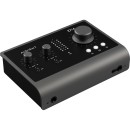
Audient iD14 MKII |
VS | ||||||||
|---|---|---|---|---|---|---|---|---|---|
| Analog: 2 Inputs / 6 Outputs at 96 kHz Digital: 8 Input / 0 Output at 48 kHz |
Channels of I/O |
Analog: 2 Inputs / 2 Outputs at 192 kHz |
Analog: 2 Inputs / 2 Outputs at 96 kHz |
Analog: 4 Input / 4 Output at 192 kHz |
Analog: 4 Inputs / 4 Outputs at 192 kHz |
Analog: 2 Inputs / 2 Outputs |
Analog: 4 Inputs / 4 Outputs at 96 kHz |
10 Input / 14 Output |
Analog: 2 Inputs / 4 Outputs Digital: 8 Inputs / 0 Outputs |
| 96 kHz / 24-Bit | Maximum Sampling Rate | 192 kHz / 24-Bit | 96 kHz / 24-Bit | 192 kHz / 24-Bit | 192 kHz / 24-Bit | 192 kHz / 24-Bit | 96 kHz / 24-Bit | 96 kHz / 32-Bit | 192 kHz / 24-Bit |
| 2 Preamps | Number of Microphone Inputs | 2 | 1 Preamp | 2 Preamps | 2 | 2 Preamps | 4 Preamps | 2 Preamps | 2 Preamps |
| 2x Combo XLR-1/4" TRS Balanced Mic/Line Input 1x 1/4" TRS Unbalanced Hi-Z Input (Front Panel) 4x 1/4" TRS Balanced Line/Monitor Output 1x 1/4" TRS Unbalanced Headphone Output (Front Panel) 1x 1/8" / 3.5 mm TRS Unbalanced Headphone Output (Front Panel) |
Analog Audio I/O |
2x XLR 3-Pin Balanced Mic Input 2x 1/4" TRS Balanced/Unbalanced Line/Hi-Z Input (Front Panel) 2x 1/4" TRS Balanced Monitor Output 1x 1/4" TRS Headphone Output (Front Panel) |
1x Combo XLR-1/4" TRS Balanced Mic/Line Input 1x 1/4" TRS Unbalanced Hi-Z Input (Front Panel) 2x 1/4" TRS Balanced Monitor Output 1x 1/4" TRS Unbalanced Headphone Output (Front Panel) 1x 1/8" / 3.5 mm TRS Unbalanced Headphone Output (Front Panel) |
2x Combo XLR-1/4" TRS Balanced/Unbalanced Mic/Line/Hi-Z Input (Front Panel) 2x 1/4" TRS Balanced Line Input 4x 1/4" TRS Balanced Line Output 1x 1/4" TRS Unbalanced Headphone Output (Front Panel) |
2x Combo XLR-1/4" 3-Pin Balanced/Unbalanced Mic/Line/Hi-Z Input (Front Panel) 2x 1/4" TRS Balanced/Unbalanced Line Input 4x 1/4" TRS Balanced/Unbalanced Line/Monitor Output 1x 1/4" TRS Headphone Output (Front Panel) |
2x Combo XLR-1/4" TRS Balanced/Unbalanced Mic/Line/Hi-Z Input (Front Panel) 2x 1/4" TRS Balanced Monitor Output 1x 1/4" TRS Unbalanced Headphone Output (Front Panel) |
4x Combo XLR-1/4" TRS Balanced Mic/Line Input (Pin 2 Hot) 1x 1/4" TS Unbalanced Hi-Z Input (Front Panel) 4x 1/4" TRS Balanced Line Output (Tip Hot) 2x 1/4" TRS Unbalanced Headphone Output |
2x Combo XLR-1/4" 3-Pin Mic/Line Input 1x 1/4" TS Unbalanced Hi-Z Input (Front Panel) 2x 1/4" TRS Balanced Insert Send 2x 1/4" TRS Balanced Insert Return 4x 1/4" TRS Balanced Monitor Output 1x 1/4" TRS Headphone Output (Front Panel) 1x 1/8" / 3.5 mm TRS Headphone Output (Front Panel) |
2x Combo XLR-1/4" TRS Balanced/Unbalanced Mic/Line/Hi-Z Input (Front Panel) 4x 1/4" TRS Balanced Line/Monitor Output 1x 1/4" TRS Unbalanced Headphone Output (Front Panel) |
| 1x TOSLINK Optical ADAT / S/PDIF Input (S/MUX Support) | Digital Audio I/O | - | - | - | - |
1x TOSLINK Optical ADAT / S/PDIF Input 1x TOSLINK Optical ADAT / S/PDIF Output |
1x TOSLINK Optical ADAT Input (S/MUX Support) | ||
| 1x USB-C | Host Connection | 1x USB-C | 1x USB-C | 1x USB-C | 1x USB-C | 1x USB-C | 1x USB-C | 1x USB-C | 1x USB-C |
| macOS 10.11.6 or Later macOS 11.1 or Later Windows 7 or Later |
OS Compatibility |
macOS Windows |
macOS 10.11.6 or Later macOS 11.1 or Later Windows 7 or Later 6 or Later iPadOS |
macOS 10.12 or Later Windows 7 or Later |
macOS Windows |
macOS 10.14 or Later Windows 10 (64-Bit Only) 14 or Later iPadOS 14 or Later |
macOS 10.7.5 or Later Windows 7 or Later (32-/64-Bit) |
Windows macOS |
macOS 10.11 or Later macOS 11 Windows 7 or Later |
| USB Bus Power | Power Requirements | USB Bus Power, USB Power Adapter (Not Included) | USB Bus Power | USB Bus Power | USB Bus Power, USB Power Adapter (Not Included) | AC/DC Power Adapter (Not Included) or USB Bus Power | USB Bus Power | USB Bus Power | AC/DC Power Adapter (Included) or USB Bus Power |
